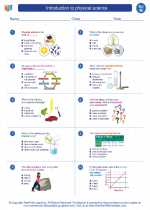Static Friction
Static friction is the force that resists the initiation of sliding motion between two surfaces that are in contact and at rest relative to each other. It occurs when an object is at rest and a force is applied to it, but the object does not move. The maximum force of static friction that can be exerted between two surfaces depends on the nature of the materials and the force pushing the surfaces together.
Factors affecting static friction:
- Nature of the surfaces in contact
- Normal force pressing the surfaces together
Equation for calculating static friction:
The force of static friction (Fs) can be calculated using the equation:
Fs ≤ μs * N
Where:
- Fs is the force of static friction
- μs is the coefficient of static friction
- N is the normal force
Study Guide:
When studying static friction, it's important to understand the following key concepts:
- Coefficient of static friction: This is a dimensionless quantity representing the amount of friction between two surfaces. It is a constant value that depends on the materials in contact. The higher the coefficient of static friction, the greater the force required to initiate movement between the surfaces.
- Maximum static friction: This is the maximum force of static friction that can be exerted between two surfaces before sliding motion occurs. It is determined by the coefficient of static friction and the normal force pressing the surfaces together.
- Applications of static friction: Static friction plays a crucial role in various real-life situations, such as preventing slipping when walking, enabling the gripping of tires on the road, and allowing objects to remain stationary on inclined surfaces.
Understanding these concepts will help you grasp the principles of static friction and its significance in the world around us.
.




